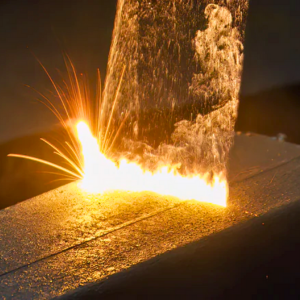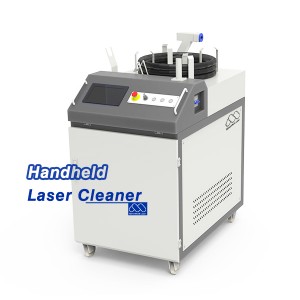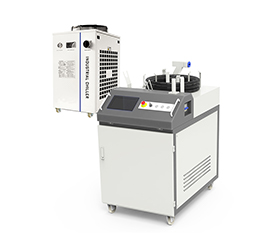Understanding Laser Cleaning Machines
Laser cleaning machines have emerged as a revolutionary solution for various industrial cleaning applications.
Unlike traditional methods, laser cleaning offers precision, efficiency, and a lower environmental impact.
This article delves into the process, principles, safety, stability, and environmental benefits of laser cleaning.
The Process of Laser Cleaning
Laser cleaning involves the use of high-intensity laser beams to remove contaminants from surfaces.
The process typically includes the following steps:

Laser Cleaning Rust on Metal
1. Preparation
The surface to be cleaned is inspected to determine the extent and type of contamination.
This could range from rust and paint to grease and other residues.
2. Setup
The laser cleaning machine is calibrated based on the material type and the level of contamination.
This ensures optimal cleaning without damaging the underlying material.
3. Cleaning
The laser beam is directed at the surface.
The energy from the laser heats the contaminants, causing them to evaporate or be blown away by the force of the emitted light.
This process is non-contact, meaning there is minimal risk of abrasion or damage to the substrate.
4. Post-Cleaning Inspection
After the cleaning process, the surface is inspected to ensure that all contaminants have been removed and that the substrate remains intact.
Principles of Laser Cleaner Machine
The principles behind laser cleaning are rooted in physics and optics.
Here are the key concepts:
1. Laser Energy Absorption
Different materials absorb laser energy at varying rates.
Contaminants like rust or paint typically absorb laser light more effectively than the underlying metal, allowing for selective cleaning.
2. Thermal Shock
The rapid heating of contaminants creates thermal shock, which can cause them to crack and dislodge from the surface.
This effect is particularly effective for brittle materials.
3. Plasma Formation
At high energy levels, the laser can create a plasma state, which enhances the cleaning process by breaking down the contaminants' molecular bonds.
4. Controlled Depth
The intensity and focus of the laser can be adjusted to ensure that only the unwanted material is removed, preserving the integrity of the underlying surface.
Safety Considerations of Handheld Laser cleaner
While laser cleaning is generally safe, certain precautions should be taken:
1. Protective Gear
Operators should wear appropriate safety gear, including laser safety goggles, gloves, and protective clothing to shield against exposure.
2. Area Containment
The cleaning area should be enclosed or shielded to prevent unintended exposure to bystanders.
3. Ventilation
Proper ventilation is essential to disperse any harmful fumes or particles released during the cleaning process.
4. Training
Operators must be adequately trained to handle laser cleaning machines responsibly, ensuring they understand both the equipment and safety protocols.
Cleaning Laser’s Stability and Reliability
Laser cleaning machines are known for their stability and reliability:
1. Durability
Many laser cleaning systems are built to withstand harsh industrial environments, featuring robust components that ensure long operational life.
2. Consistency
The precision of laser cleaning allows for consistent results, reducing the likelihood of human error common in manual cleaning methods.
3. Minimal Maintenance
With fewer moving parts compared to traditional cleaning methods, laser cleaning machines require less maintenance, making them a cost-effective solution in the long run.
Environmental Protection of Laser Cleaner Metal
One of the standout features of laser cleaning is its minimal environmental impact:
1. No Chemical Use
Unlike conventional cleaning methods that often rely on harsh chemicals, laser cleaning uses only light, reducing the risk of chemical spills and contamination.
2. Waste Reduction
The precision of laser cleaning allows for consistent results, reducing the likelihood of human error common in manual cleaning methods.
3. Energy Efficiency
Advances in laser technology have led to more energy-efficient machines, lowering the overall carbon footprint associated with cleaning operations.
Conclusion
Laser cleaning machines represent a significant advancement in cleaning technology.
Their efficient, safe, and environmentally friendly approach makes them an ideal choice for various industries.
As technology continues to evolve, the adoption of laser cleaning is likely to expand, further enhancing its role in sustainable industrial practices.

Laser Rust Cleaning on Metal
FAQS
Laser cleaning machines work on diverse materials like metal (for rust/oxide removal), composites, plastics (paint stripping), and stone (stain cleaning). They’re used on automotive parts (engine rust), aerospace components (coating removal), and artwork (gentle decontamination). Match laser parameters (power, pulse) to the material—low - power pulsed lasers suit delicate surfaces, high - power ones tackle thick metal rust.
It’s safe with precautions. Wear laser safety goggles (blocking specific wavelengths), use enclosed work areas to avoid bystander exposure, ensure proper ventilation (to remove fumes from vaporized contaminants), and train operators on emergency stops/settings. Following protocols minimizes risks like eye injury or fume inhalation, making it safer than chemical/abrasive methods.
Yes, in many cases. They offer better precision (no surface damage), use no chemicals (eco - friendly, no waste), are faster for repetitive tasks (like automotive assembly lines), and work on complex shapes (aerospace parts) where sandblasting fails. While not ideal for extremely thick coatings (e.g., 10mm paint), they outdo traditional methods for most industrial cleaning, boosting efficiency and sustainability.
Want To Know More About Laser Cleaner?
Related Machine: Laser Cleaners
The pulsed fiber laser featuring high precision and no heat affection area usually can reach an excellent cleaning effect even if under a low power supply.
Due to the noncontinuous laser output and high peak laser power, the pulsed laser cleaner is more energy-saving and suitable for fine parts cleaning.
Distinct from pulse laser cleaners, this high - power laser cleaner, leveraging continuous wave laser, achieves higher - power output. This translates to faster cleaning speed and a larger cleaning coverage area.
Post time: Dec-31-2024



